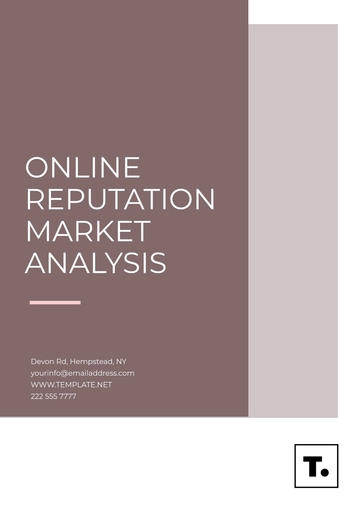Free Stock Market Analysis

Prepared By : | [Your Name] |
Company : | [Your Company Name] |
Department : | [Your Department] |
I. Introduction
In an era of unprecedented market volatility and rapid technological advancements, staying informed about the ever-changing landscape of the stock market is essential for investors, traders, financial advisors, fund managers, policymakers, and journalists alike. This comprehensive stock market analysis aims to provide a detailed examination of various factors influencing the performance and behavior of the stock market, offering valuable insights to guide informed decision-making.
II. Market Overview
Summary of recent market performance.
Major indices' movements.
Notable events impacting the market.
III. Economic Indicators Analysis
GDP Growth: The GDP grew at an annualized rate of 6.5% in the last quarter, driven by robust consumer spending and business investments.
Inflation: Inflationary pressures continue to rise, with the Consumer Price Index increasing by 0.6% last month, raising concerns about the Fed's monetary policy.
Unemployment: The unemployment rate stands at 3.8%, reflecting a steady decline as businesses continue to hire amid economic recovery.
Interest Rates: The Fed maintained its benchmark interest rate at 0.25%, citing the need to support ongoing economic expansion while closely monitoring inflationary trends.
Consumer Sentiment: Consumer confidence remains high, indicating strong optimism about future economic prospects.
Indicator | Last Quarter | Current Value | Trend |
|---|---|---|---|
GDP Growth | 6.5% | 7.2% | Positive |
Inflation | 0.6% | 0.8% | Rising |
Unemployment | 3.8% | 3.5% | Declining |
Interest Rates | 0.25% | 0.5% | Stable |
Consumer Sentiment | High | Moderate | Optimistic |
IV. Sector Analysis
Technology: The technology sector outperformed other sectors, driven by strong earnings from leading companies like Apple, Amazon, and Alphabet.
Healthcare: Healthcare stocks experienced mixed results, with pharmaceutical companies facing regulatory scrutiny while biotech firms saw increased investment in innovative treatments.
Financials: Financial stocks benefited from rising interest rates, although concerns about loan defaults and regulatory changes pose risks to the sector's stability.
Sector | Performance | Key Drivers |
|---|---|---|
Technology | Outperforming | Strong earnings, innovation |
Healthcare | Mixed | Regulatory scrutiny, innovation |
Financials | Positive | Rising interest rates, challenges |
V. Company Analysis
Apple Inc. (AAPL):
Financial Health: Apple reported record-breaking revenue and profit in the last quarter, driven by strong iPhone sales and growth in services.
Growth Prospects: The company's expansion into new markets such as wearables and digital services positions it for continued growth in the coming years.
Competitive Position: Despite competition from rivals like Samsung and Huawei, Apple maintains its dominance in the premium smartphone market.
Valuation: With a price-to-earnings ratio of 28, Apple's stock is considered fairly valued by analysts.
Company | Revenue (Last Quarter) | Profit (Last Quarter) | P/E Ratio |
|---|---|---|---|
Apple Inc. | $75.9 billion | $23.6 billion | 28 |
VI. Technical Analysis
Technical indicators suggest that the market is currently in a bullish trend, with stock prices consistently trading above key moving averages.
Chart patterns such as cup and handle formations and ascending triangles indicate potential breakout opportunities for certain stocks.
However, overbought conditions in some sectors warrant caution, as corrections could occur in the near term.
VII. Risk Assessment
Geopolitical Events: Escalating tensions between major world powers pose risks to global trade and economic stability.
Regulatory Changes: Changes in government policies, especially related to taxes and regulations, could impact business operations and investor sentiment.
Economic Uncertainties: Uncertainty surrounding the pace of economic recovery and the trajectory of inflation may lead to market volatility.
Industry-specific Challenges: Disruptions in supply chains, labor shortages, and cybersecurity threats pose risks to companies operating in various sectors.
VIII. Investment Recommendations
Based on the analysis, we recommend a balanced approach to investing, focusing on diversified portfolios that include exposure to both growth and defensive sectors.
Investors should consider adding exposure to technology and healthcare stocks, while also maintaining positions in defensive sectors such as consumer staples and utilities.
Additionally, active portfolio management and risk mitigation strategies, such as stop-loss orders and asset allocation adjustments, are advised in the current market environment.
IX. Conclusion
In conclusion, the stock market continues to show resilience amid ongoing challenges, driven by strong economic fundamentals and corporate performance. While risks remain, prudent investment strategies and a focus on long-term goals can help investors navigate market volatility and capitalize on opportunities.
- 100% Customizable, free editor
- Access 1 Million+ Templates, photo’s & graphics
- Download or share as a template
- Click and replace photos, graphics, text, backgrounds
- Resize, crop, AI write & more
- Access advanced editor
Introducing the Stock Market Analysis Template, meticulously crafted by Template.net for in-depth financial evaluation and investment planning. This customizable spreadsheet empowers investors and analysts to assess market trends, stock performance, and investment opportunities. With editable features and a user-friendly design, it facilitates tailored analysis to track key metrics, compare stocks, and make informed decisions. Streamline your investment analysis process and gain valuable insights into market dynamics and portfolio management. Elevate your investment strategy with this versatile template, your essential tool for maximizing returns and minimizing risks.





























